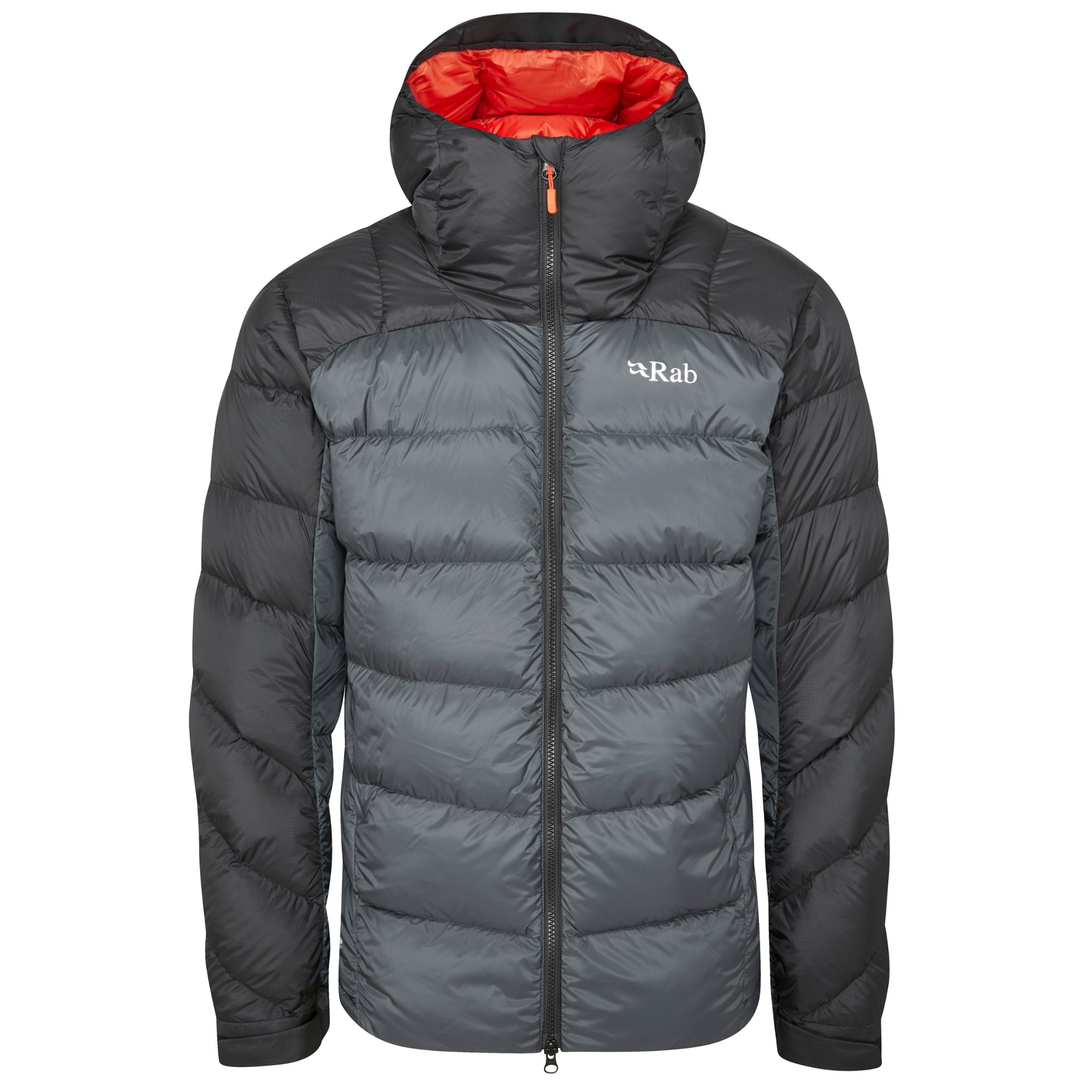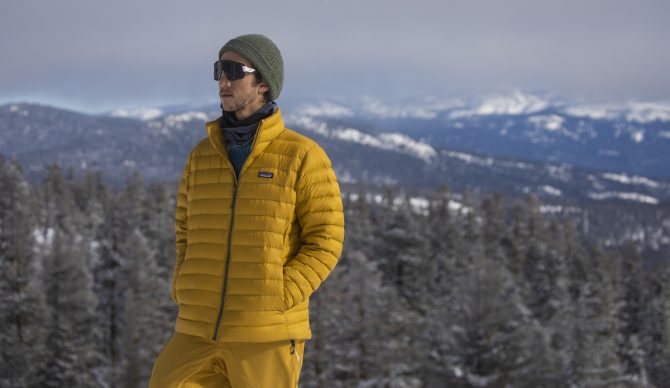
Taking the updated Patagonia Down Sweater for a spin. Photo: Ryan Salm//The Inertia
Puffer jackets are our go-to for cold-weather pursuits. They provide the most warmth out of any type of insulating layer, can pack down the smallest for easy transport, and with today’s latest material technology, can even repel a bit of rain while doing so.
Down has historically been the material of choice when it comes to puffy insulation thanks to its exceptional warmth-to-weight ratio, breathability, and packability, but it’s not the only option, and in this article, we look at all kinds of puffer jackets, including down, synthetic, and even merino wool options.
For ease of comparison, we broke the options down into Lightweight, Midweight, and Heavyweight puffers. When deciding which jacket to purchase, we recommend choosing a fill weight based on how you plan to use your puffer jacket the most.
Navigate To: Comparison Table | How We Tested | Buyer’s Guide
Related: Winter Gear Reviews | Best Winter Jackets (Men) | Best Women’s Puffer Jackets
Editor’s Note: We most recently updated this guide in November 2025 with some new picks, updated navigation, and refreshed links. We also added links for hooded/non-hooded versions, as applicable.
The Best Men’s Puffer Jackets
Best Midweight Puffer Jacket: Patagonia Down Sweater
Best Heavyweight Puffer Jacket: Rab Neutrino Pro
Best Lightweight Puffer Jacket: Mountain Hardwear Ghost Whisperer
Best Budget Puffer Jacket: REI Co-op 650 Down Jacket
Best Technical Puffer Jacket: Arc’teryx Cerium Hoody
Best Midweight Puffer Jacket
Patagonia Down Sweater ($279)
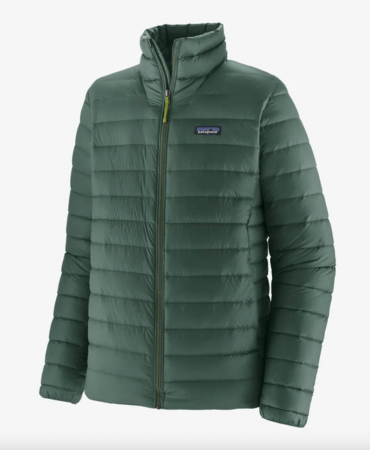
Category: Midweight
Insulation: 5.0 oz of 800 fill-power down
Weight: 13 oz
Other Style Options: Hooded ($330)
Pros: Incredible all-rounder with sustainability chops and timeless appeal
Cons: More of a focus on casual wear/style than lightweight performance
The Patagonia Down Sweater is iconic for a reason. This packable puffy jacket brings incredible coziness and top-notch sustainability with an 800-fill Responsible Down Standard lining, a PFC-free water-repellent finish that wards off light drizzles, and more. It’s pretty light, super toasty, and quite hard to take off.
We’ve seen this jacket in many different iterations over the years, and when we got our hands on the latest version, we were stoked on the updates this timeless classic has received since our first encounters with the Patagonia Down Sweater. The jacket now sports three internal pockets – two drop-in and one zippered chest pocket (which it packs into for easy storage), as well as the two external (zippered) handwarmer pockets. The jacket is also made from recycled fishing nets, and an included patch kit is ready for whenever the first tear occurs.
As mentioned earlier, the PFC-free DWR, in combination with the slightly stiffer face fabric, is sufficient for light drizzles, but we wouldn’t recommend getting caught in much heavier rain. While it’s not the most technical piece, the Down Sweater is a truly versatile puffer. The price is fairly middle-of-the-pack, but on the value side of things, it helps to know that this option is easy on the planet and will stay in your closet for years to come. Don’t believe us? One of our editors has a Down Sweater that’s nearly 10 years old and still looks mint.
Read our full review of the Patagonia Down Sweater (women’s version).
CHECK PRICE ON BackcountryBest Heavyweight Puffer Jacket
Rab Neutrino Pro Hoodie ($425)
Category: Heavyweight
Insulation: 7.5 oz of 800 fill-power goose down
Weight: 19.9 ounces
Pros: Comfortable and ultra-warm puffer with a Pertex Quantum Pro outer shell for water-resistance and durability
Cons: A bit less packable than your classic puffer with the added weather-resistance
Rab’s Neutrino Pro is a top pick in many winter jacket and puffer jacket reviews, and deservedly so. With plenty of toasty 800 fill-power down, this jacket is a true heavyweight puffer, made to keep you warm in the coldest of conditions. The special sauce, however, lies in the Pertex Quantum Pro outer shell, a windproof and highly water-resistant material that also adds a touch of durability in comparison to most puffer jacket face fabrics. However, it does so without compromising mobility and retaining solid packability as well.
The jacket has a bit of a looser fit as well for easy layering underneath, is fully capable of layering over a ski jacket to stay warm while taking a break out in the backcountry, and it packs down well to fit in a backpack when it’s time to get moving again. Also of note is the price point; while $425 isn’t cheap, this jacket presents an awesome value at that price, with sufficient warmth and layering capability to replace a bulkier winter jacket in all but the wettest of conditions. If it’s truly raining, though, you’ll certainly be better served with a jacket that is actually waterproof.
In comparison to the Mythic Ultra, also from Rab, below, the Neutrino Pro offers the aforementioned looser fit for easier layering underneath, a touch less warmth, and that more durable outer shell which presents more of a robust jacket, similar to options like The North Face Retro Nuptse, below (though the Neutrino Pro is much more mobile and better for active pursuits, presenting a best-of-both-worlds puffer/winter jacket combo).
CHECK PRICE ON BackcountryBest Lightweight Puffer Jacket
Mountain Hardwear Ghost Whisperer ($350)
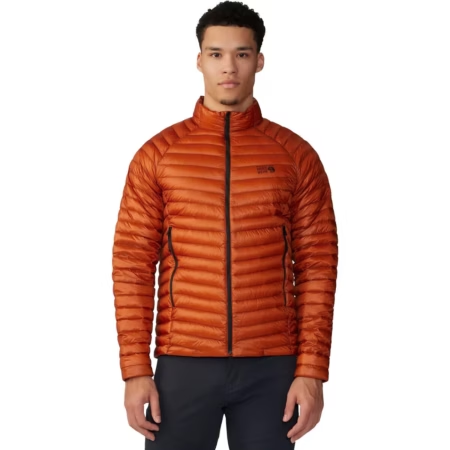
Category: Lightweight+
Insulation: 3.0 oz of 800 fill-power down
Weight: 8.8 oz
Other Style Options: Hooded ($380), Ultralight ($450)
Pros: Great warmth for an ultra-lightweight down jacket
Cons: A bit pricey
The Mountain Hardwear Ghost Whisperer has been a staple in the lightweight insulation category for years, and with good reason – it hits the sweet spot in so many ways. It’s very lightweight at 8.8 oz, but doesn’t compromise on durability in the name of weight savings. It packs on plenty of warmth to be used on its own, and is one of the warmer lightweight jackets we’ve tested, but it also works great as a midlayer for activities like skiing and snowboarding in moderately cold conditions.
That perfect balance, along with a robust set of features like zippered pockets, an elasticated hood, and an adjustable hem (some ultralight jackets cut down on such features to reduce weight), makes this our top pick for lightweight puffer jackets.
Other great options include the Rab Mythic G, below, which packs on as much warmth as a midweight puffer jacket, while clocking in at only an ounce heavier than the Ghost Whisperer here. However, its price and durability pushed it down the rankings. A more budget-friendly choice is the Patagonia Nano Puff. Made with synthetic insulation instead of down, it isn’t as warm, but costs about $100 less.
CHECK Jacket PRICE ON Backcountry Check Hoodie Price on Backcountry
Best Budget Puffer Jacket
REI Co-op 650 Down Jacket ($129)
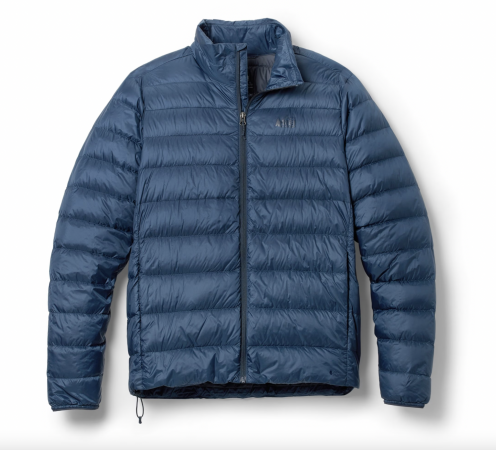
Category: Lightweight+
Insulation: 650 fill-power of RDS-certified down
Weight: 10.9 oz
Other Style Options: Hoodie ($150)
Pros: Incredible value for price, full suite of features
Cons: Boxier fit, some complaints of build quality
For the past couple of years, Decathlon won the “best budget puffer” game by hitting the golden mark of a $100 down jacket with its Simond MT100 jacket, featured below, but this year the price on that piece jumped to $120, and so for only $10 more ($30 more if you want the hooded version), REI Co-op’s 650 Down Jacket takes the cake with slightly warmer insulation, a full suite of features, and recycled materials.
While REI carries plenty of premium brands, with price tags to match, its own line of clothing and equipment has proven it can go toe-to-toe with the big boys, while maintaining a staggeringly low price point. The 650 Down Jacket is no exception, with a solidly warm 3.0 oz of 650 fill-power down, and features like interior drop-in pockets, zippered hand pockets, and it can be packed into the left-hand pocket for easy storage.
The only downsides include the fact that it’s not a leader in warmth and has a bit of a boxier fit. That’s both a pro and a con – a pro for layering, but a con if worn by itself, as it can be a bit draftier. If you prefer more of a trim fit, check out the Decathlon Simonds Puffer, our runner-up best budget, below. Finally, while we’ve had no issues ourselves, there have been some complaints online about build quality. However, the positive reviews vastly outweigh the negative ones (and mostly seem to be about the prior version of the jacket), and REI’s top-notch return policy should assuage any fears in that department.
CHECK PRICE ON REIBest Technical Puffer Jacket
Arc’teryx Cerium Hoody ($400)
Category: Lightweight+
Insulation: 850-fill Down with Coreloft synthetic in targeted areas
Weight: 11.9 oz
Other Style Options: Jacket ($380)
Pros: Midweight warmth in a lightweight jacket, down/synthetic hybrid for optimal insulation
Cons: Stuff sack isn’t integrated, pricey
If you are an avid climber, backpacker, or backcountry skier, the Arc’teryx Cerium Hoody is likely to be the best lightweight puffer jacket you can buy. With hybrid insulation comprised of 850-fill down and Coreloft synthetic insulation in wet-prone areas (armpits, shoulders), the Cerium is the warmest lightweight jacket we’ve tested. The jacket maintains superb loft, and the fit is cut to move with you—it’s slim and spacious in the right areas. Plus, as versatile as it is in active pursuits, the Cerium looks great as your go-to jacket around town.
While the Arc’teryx Cerium Hoody doesn’t stuff into its own pocket, it does come with a small stuff sack that can be easily attached to a clip in the pocket. It packs down to about the size of a Nalgene, which, admittedly, is bigger than other lightweight puffer jackets, likely due to the extremely lofty 850-fill down. That said, at 11.9 ounces, the Cerium is a true lightweight puffer, especially considering how warm this jacket is.
The fit of a puffer jacket can make or break its utility, and the Cerium’s fit is one of the best we’ve tested. We measure fit against our other top picks, and this Arc’teryx puffer stacks up as one of the best. Sure, this jacket is expensive, but the Cerium will serve you well wherever you roam for years to come.
Check Price on REI
If warmth is what you’re looking for, you’ll be hard-pressed to beat the Rab Mythic Ultra. Photo: Ryan Salm//The Inertia
More Puffer Jackets We Recommend
Our top six picks are tried and true puffer jackets for a range of activities. But don’t miss our full list: We’ve got a handful of excellent men’s puffer jackets that maintain important spots in our gear closet. Check out the rest of our recommendations below.
Best Value Puffer Jacket
REI Magma 850 Down Jacket ($240)
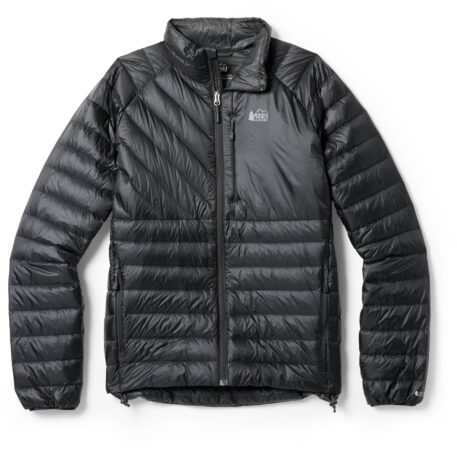
Category: Midweight
Insulation: 850 fill-power down
Weight: 11 oz
Other Style Options: Hooded ($269)
Pros: Great value for a high-quality down jacket
Cons: Not the most stylish option, no synthetic fill in moisture-prone areas
It’s not often that a brand can significantly undercut the price of competitors and still put out a product that rivals top-quality options, but in our testing, the REI Co-op Magma 850 Down Hoodie is a winner. The design is simple, yet it features everything we want in a capable down jacket—good fit, warm, and packable. The down fill (850) is excellent, and the Magma has no business being this good at this price. The Magma 850 has all the benefits of a top-rated (and higher-priced) jacket, and comes in at $240 at the time of publishing.
Features we love include: cinchable hood, three zippered pockets (two hand, one chest), packable into its pocket with a hang loop, dual cinches on the waist, and excellent mobility and fit. The 850 fill-power down is right up there with the best, exceeding options like the Patagonia Down Sweater and matching the Arc’teryx Cerium. Both of those jackets have class-leading fit, and we felt like the Magma kept up in that department – the unique diagonal baffles on the chest and soft, pliable shell material felt like they helped in this regard.
While the Magma isn’t the most stylish option on this list, it looks right at home in a mountain town brewery or cafe. Sure, you’re not getting the synthetic fill in moisture-prone areas, and this is by no means a truly warm, heavyweight puffer, but with a price holding steady and so much to love, this is definitely the best value puffer jacket we’ve tested, especially if your needs lean toward outdoor pursuits.
Check Price on REISuper Warm, Super Lightweight
Rab Mythic Ultra ($495)
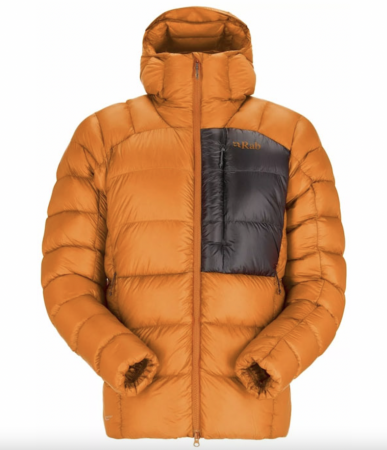
Category: Heavyweight
Insulation: 8.5 oz of 900 fill-power down
Weight: 18.9 oz
Pros: Insane warmth paired with lightweight packability
Cons: Too warm for active pursuits, outer shell isn’t super durable
Pulling on the Rab Mythic Ultra is a (dare we say it?) life-changing experience in hyper-cozy warmth. Once you’ve donned this lightweight cloud of a jacket, no other puffer will feel the same. The jacket sports 8.5 oz of 900 fill-power down, but weighs just 18.9 oz, making use of a lightweight, recycled Polyamide material for the outer and inner lining. The inner lining also sports a heat-reflecting material for even more warmth.
The down inside the jacket is treated with a Nikwax hydrophobic treatment for increased performance in wet conditions, and the included stuff sack packs this jacket down to the size of about 1.5 Nalgene water bottles, a true disappearing act.
While the jacket is certainly too warm for active pursuits like skiing (and would likely produce a “Michelin Man” effect under most shell jackets), for more stationary activities like snow camping, belaying in the cold, or just walking around town, you’ll be hard-pressed to find its equal. With supreme packability and warmth-for-weight ratio, this is a technical piece of equipment made for superior warmth in truly cold conditions.
CHECK PRICE ON BackcountryRunner-Up Best Budget Puffer Jacket
Decathlon Simond MT100 ($119)
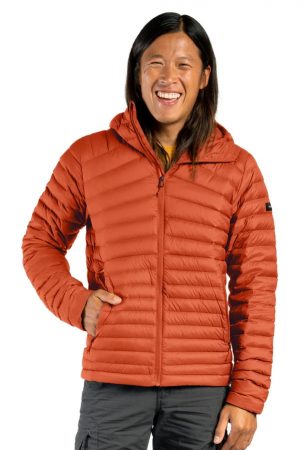
Category: Lightweight
Insulation: 800 fill-power RDS-certified down
Weight: 10.22 oz
Pros: Well-made and comfortable, hooded, for just over $100
Cons: Missing features such as interior drop-in/chest pockets, fairly lightweight insulation
There’s a reason why puffer jackets have become a bit of a status symbol nowadays – they don’t come cheap. However, as with most things outdoors-related, Decathlon, the French sporting goods mega-retailer (the largest in the world, as a matter of fact) has cracked the code when it comes to bang-for-buck puffer jackets. $120 isn’t cheap, per se, but when you’re comparing it to products that rarely dip below $300, it’s a price that’s very, very hard to beat while still producing a quality product.
Admittedly, that low price comes at its own cost – Decathlon products sometimes get a bad rap for being cheaply made, but we found that not to be the case with the Simond Mt100 jacket. While you do sacrifice features like interior pockets, a cinch at the hem, or a chest pocket, and it’s a relatively lightweight puffer compared to some options on this list, the materials used are of good quality, it’s well constructed, has a trim, clean look, and comes with a hood, presenting an incredible bang-for-buck option in the puffer jacket category. Durability-wise, we’ve had this jacket in our regular-use rotation for the past three years, and it’s holding up quite well, showing some wear and tear as any puffer would, but overall, we anticipate getting many more years of use out of this jacket.
CHECK PRICE ON DECATHLONRetro Style
The North Face 1996 Retro Nuptse ($330)
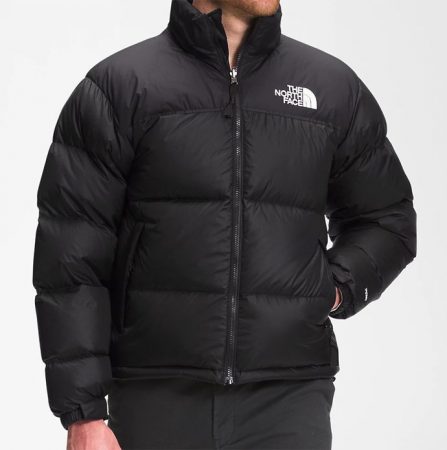
Category: Heavyweight
Insulation: 700 fill-power down
Weight: 27.34 oz
Pros: Warm, with lasting “retro” style that is all the rage this winter
Cons: On the heavier side, boxy, overstuffed fit places an emphasis on style over functionality for outdoor activities
No puffer jacket review would be complete without The North Face, which has been a leader in the space for decades. Its 1996 Retro Nuptse Jacket is a classic, having perfected the boxy, oversized puffer look that has seen a recent resurgence in popularity.
While the jacket isn’t necessarily geared towards high-performance or active pursuits, if the puffer you’re looking for will do most of its work looking good and keeping you warm around town or in the city, look no further. The jacket is available in a wide variety of colors, from the classic blue/black to neon yellow, and has a robust feature set, including zippered hand-pockets (it packs into the right-hand one to a surprisingly small size), a thin, uninsulated hood that packs into the collar, and an inside zippered chest pocket.
Check Price on BackcountryBest Puffer For Those Who Hate Puffers
Mountain Hardwear Stretchdown Parka ($380)
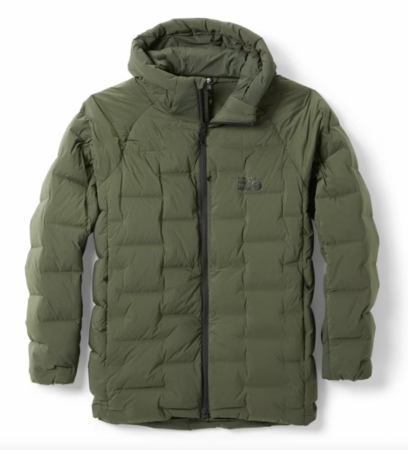
Category: Heavyweight
Insulation: 700 fill-power goose down
Weight: 27.3 oz
Other Style Options: Jacket ($290), Hooded Jacket ($320), Light Jacket ($280)
Pros: Stretchy outer fabric provides comfortable ease of movement and durability
Cons: Boxy fit
While we can’t say who started the stretch-puffer movement, it’s safe to say that Mountain Hardwear has helped push this category to the forefront with its series of Stretchdown jackets, vests, and more. If you’re someone who doesn’t like that slick nylon feeling of most puffer jackets on the market, this one’s for you.
The stretch shell fabric is the most notable feature of these jackets, allowing them to move with you in a way that puffer jackets are rarely able to accomplish. The stretch fabric is also more durable than the classic “ripstop” puffer material and will help keep this item looking new far longer than your average puffer. And as we said previously, the overall feel of the fabric is a lot more like a regular fabric than a space-age material.
The Stretchdown Parka is the warmest Stretchdown offering, with solid 700-fill-power down insulation, a longer hem that extends past the hips, and a cozy hood and collar with full wrap-around coverage that fits perfectly just under the chin for max warmth without being too cumbersome. The fit is a bit on the boxy side, reducing warmth potential as a stand-alone piece, but allowing for better layering underneath.
If the parka is too much insulation for your needs, Mountain Hardwear has a full line of stretchdown products, including jackets, pullover sweatshirt-style pieces, vests, and even pants. Other favorite puffers of ours in the Stretchdown category include the Stretchdown Jacket, a midweight design that’s comparable in warmth to the Patagonia Down Sweater.
Check Price on BackcountryA Super Eco-Friendly Puffer Jacket
Jones Re-Up Down Recycled Hoodie ($330)
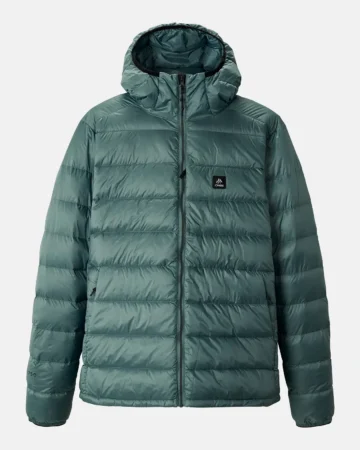
Category: Midweight+
Insulation: 750 fill-power recycled down
Weight: Not listed
Pros: Very warm for the weight, super sustainable
Cons: A bit too warm to layer under a shell for skiing
The Jones Re-Up Down Recycled Hoodie is a bit of a game changer, released in the fall of 2022 with 100% recycled materials – even the down insulation, a huge step forward. Jones Snowboards, founded by pro snowboarder and Protect Our Winters activist Jeremy Jones, is a company committed to sustainability, and it’s awesome to see them leading the charge with a fully-recycled puffer jacket.
Even Patagonia, often the leader in sustainability practices, doesn’t use recycled down for its insulation. The jacket itself doesn’t take a hit in performance, though, with a full feature set of handwarmer pockets, interior drop-in pockets, and a zippered chest pocket, which the jacket packs into for easy storage.
In testing, we found it to be a bit warmer than the Patagonia Down Sweater, due to a more streamlined fit, and overstuffed baffles– the Patagonia Down Sweater is a good bit boxier and doesn’t feel stuffed chock-full of down like the Jones jacket does. The only downsides are the relatively high price and lack of versatility due to the warmth – we found this jacket to run a bit too warm to work as a midlayer under a shell for skiing and snowboarding unless you find yourself riding in decently cold conditions.
CHECK PRICE ON EVORidiculously Small Pack Size
Jones Re-Up Recycled Down Jacket ($300)
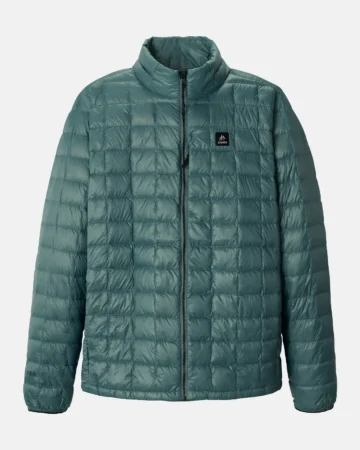
Category: Lightweight
Insulation: Recycled 750 fill-power down
Weight:
Pros: Versatile layer with a minuscule pack size
Cons: Not a winner in terms of warmth, but that’s kinda the idea
When it comes to puffy insulation, sometimes you want a jacket that will keep you as warm as humanely possible. Sometimes, you want a jacket that will provide just enough insulation to keep you comfortable, but not so much that you overheat as you exert yourself. That’s where the Jones Re-Up Recycled Down Jacket comes in. A thin puffer jacket with lightweight insulation, this has been one of our favorite options for layering under a ski shell on those in-between days where out in the sun, or at the base of the mountain, you want just a shell and a baselayer, and as you gain elevation, some extra insulation becomes necessary. The best part of this jacket, however, is the super-small pack size. Not only does it easily fit in a backpack, but we’ve found that it fits in most ski-jacket pockets, too, without any unnecessary bulk or bulging. This is pretty huge for those days in the spring that start cold and end warmer, meaning you can ski without a backpack, and still shed a layer or bundle up without needing to go back to the lodge.
While it may have almost the same name as the Jones Re-Up Recycled Down Hoodie, this is a very different puffer. The Hoodie has a lot more insulation than the jacket, and is a lot warmer, mainly intended to be worn by itself, but capable of being used as an under-shell layer on colder ski days. See above for details on that piece. The Jacket, on the other hand, is a lightweight insulator that is best used for layering, but can also be worn by itself in milder temperatures. They both feature the same suite of hand pockets, internal drop-in pockets, and a chest pocket that the jacket packs into.
CHECK PRICE ON EVOBest Long Puffer Jacket
Helly Hansen Active Long Winter Parka ($370)
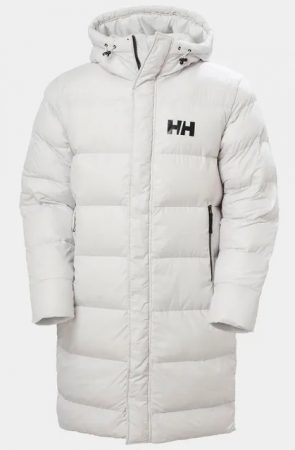
Category: Heavyweight
Insulation: Primaloft synthetic insulation
Weight: 49 oz
Pros: Super warm and cozy with a knee-length cut and style for days
Cons: Heavy and doesn’t pack down well due to the synthetic insulation
If you’re looking to stay warm and toasty in truly cold conditions, Helly Hansen has got your back (and butt) covered with the Active Long Winter Parka. Stuffed with Primaloft insulation and sporting a knee-length cut, as long as your feet and calves are warm, the rest of your body has very little to worry about.
A full-coverage and adjustable hood completes the fit, as well as low-profile wrist gaiters to keep out snow and drafts, and a solid selection of pockets, including two zippered handwarmer pockets, a hidden external chest pocket, and an internal mesh drop-in pocket for bulkier items. A two-way zipper is a matter of course for a jacket of this length, letting you keep the body zipped but free up the legs for easier movement.
The only downside to this awesome puffer is the bulk – because the insulation is synthetic, it doesn’t pack small as well as down insulation, and because of the length and heft of the jacket, this is not an item you’re going to be able to stuff in a backpack when you get too warm – unless you’ve got a really big backpack.
CHECK PRICE ON Helly HansenGreat Warmth-to-Weight Ratio
Rab Mythic G Jacket ($525)
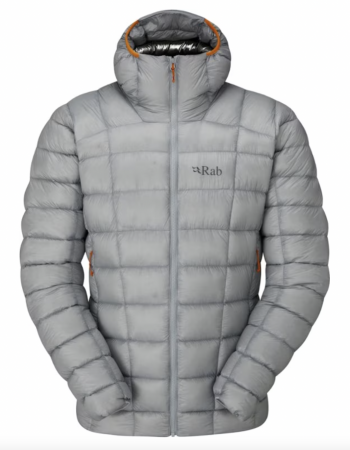
Category: Midweight+
Insulation: 1000 fill-power goose down
Pros: Super warm, super low weight
Cons: Pricey, not the most durable construction, only two pockets
Rab has been pushing the envelope recently when it comes to warmth-to-weight ratios, and the brand’s Mythic G jacket is the epitome of that endeavor.
Clocking in at only 9.8 oz, it’s only an ounce heavier than our top-pick lightweight jacket, the Mountain Hardwear Ghost Whisperer, but has the warmth and insulating power of jackets twice its weight. The 1000-fill-power down insulation is the highest fill-power on this list, and Rab’s TILT reflective lining helps retain and regulate body heat without adding more bulk. A stuff sack is included for compressing the jacket for travel/storage.
With all that in mind, we categorized this jacket as a midweight jacket. However, that insane warmth-to-weight ratio means some compromises were made to reduce weight – most notably, the outer fabric is fairly thin, and is not the most durable. The jacket also only sports two pockets (handwarmer pockets), and since it stuffs into a stuffsack rather than a pocket, if you don’t want to lose that stuffsack, you’ll probably want to keep one of those handwarmer pockets zipped shut with the stuffsack inside. This is a very minor detail, but it felt like a bit of an oversight from such a high-quality brand like Rab.
Those compromises, along with the high price, kept this jacket out of our top picks. That said, if you’re engaging in a technical endeavor like winter climbing or backcountry skiing where lightweight and supreme warmth are a priority, look no further.
CHECK PRICE ON Backcountry
A small selection of jackets we tested. These were some of our favorites. Photo: Will Sileo//The Inertia
Men’s Puffer Jackets Comparison Table
| Jacket | Price | Category | Weight | Fill | Fill Power | Fill Weight | Notable Features |
| Patagonia Down Sweater | $279 | Midweight | 13 0z | Down | 800 | 5.0 oz | Comes with repair kit, packs into pocket |
| Rab Neutrino Pro | $425 | Heavyweight | 19.9 oz | Down | 800 | 7.5 oz | Slightly weatherproof |
| Mountain Hardwear Ghost Whisperer | $350 | Lightweight+ | 8.8 oz | Down | 800 | 3.0 | Very lightweight, packs into pocket |
| REI Co-op 650 Down Jacket | $129 | Lightweight+ | 10.9 oz | Down | 650 | Not listed | Great value |
| Arc’teryx Cerium Hoody | $400 | Lightweight+ | 11.9 oz | Down | 850 | 3.5 oz down, 2.8 oz Coreloft | Body-mapped down/synthetic hybrid insulation |
| REI Magma 850 Down Jacket | $240 | Lightweight | 11 oz | Down | 850 | Not listed | Great value |
| Rab Mythic Ultra | $495 | Heavyweight | 18.9 oz | Down | 900 | 8.5 oz | Packs into stuff sack |
| Decathlon Simond MT100 Hooded | $119 | Lightweight+ | 10.22 oz | Down | 800 | 2.85 oz | Hooded, packs into pocket |
| The North Face 1996 Retro Nuptse | $330 | Heavyweight | 27.34 oz | Down | 700 | Not listed | Stowable hood, packs into pocket |
| Mountain Hardwear Stretchdown Parka | $320 | Heavyweight | 27.3 oz | Down | 700 | Not listed | Stretchy shell fabric |
| Jones Re-Up Recycled Down Hoodie | $330 | Midweight+ | Not listed | Down | 750 | Not listed | 100% recycled materials, even the down, packs into pocket |
| Jones Re-Up Recycled Down Jacket | $300 | Lightweight | Not listed | Down | 750 | Not listed | Very small pack size |
| Helly Hansen Active Long Winter Parka | $370 | Heavyweight | 49 oz | Primaloft | N/A | Not listed | Knee-length cut |
| Rab Mythic G Jacket | $525 | Midweight+ | 9.8 oz | Down | 1000 | 4.5 oz | Very warm, very lightweight |

We examined all the features and considered all the details when testing puffer jackets. Photo: Ella Boyd//The Inertia
How We Tested Men’s Puffer Jackets
Puffer jackets is an interesting category because the term, in fact, covers many different options. Down jackets, synthetic-insulated jackets, lightweight puffers made for high-output activities, heavyweights for snow camping and staying warm while stationary, and stylish parkas made for the city. And now, there are merino wool and even alpaca wool puffer jackets as well, pushing the boundaries of sustainability in puffy insulation.
For this review, lead tester Will Sileo has spent the last three years keeping a close eye on the puffer jacket market and getting his hands on the latest and greatest for testing. Based in San Francisco, and with frequent trips to Lake Tahoe, the frigid Northeast, and the Pacific Northwest, Sileo has the perfect varied testing environment to determine the best all-around puffer jackets for a variety of temperatures and conditions.
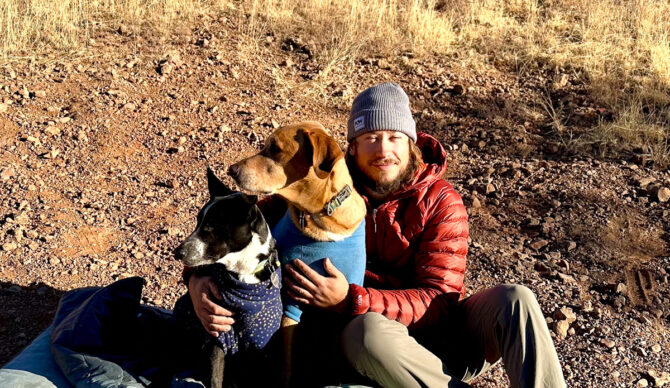
all cozied up in the REI Magma 850 Down Hoodie. Photo: Nate Lemin//The Inertia
Nathan Lemin, our other gear editor, also contributed to the testing of this guide. An experienced backpacker, hiker, and snowboarder, Lemin tested puffer jackets in a range of conditions, from sub-freezing nights in the backcountry to high-elevation expeditions in Northern Arizona.
We first published this review in the winter of 2022, and since then, we have continued to keep the article regularly updated as new products hit the market. We updated this guide in January 2024 with four new jackets, updated the listings for the Jones and REI puffers, which received big improvements in the fall of 2023, and adjusted our rankings based on our continued testing. Then we recalibrated in November 2024 with a couple of new picks (the incredible Arc’teryx Cerium Hoody and Rab Neutrino Pro), and removed some that no longer represented the top options. In our November 2025 update, we added the REI Magma 850, removed a couple of options that have been discontinued, and added additional photos.

From the slopes to the ski town, puffer jackets are our go-to winter wear. Photo: Ella Boyd//The Inertia
Men’s Puffer Jackets Buyer’s Guide
When it comes to buying a jacket, not all puffers are created equal. Since the puffy jacket will be your warmest outer layer, you want to make sure you’re purchasing one that’s going to get the job done.
For ease of comparison, we divided this review into three categories: lightweight, midweight, and heavyweight puffer jackets. Lightweight puffers are best for high-output activities like backcountry skiing, and winter trail running, or as a light outer layer for spring, summer, and fall, depending on where you live. We find ourselves reaching for a midweight puffer to layer over a sweatshirt or fleece for nights that get down to about 50 degrees Fahrenheit or as a main insulating layer for colder resort-skiing days. Heavyweight puffers truly shine in low-output activities in the cold, like snow or winter camping, belaying, and exploring colder cities like New York or Chicago, but our favorite use for them is for post-surf warmth when we need some insane insulation to stop the shivers.

The Ibex Wool Aire Jacket (discontinued) features wool insulation rather than down or synthetic. Photo: Skyler Fitzmaurice//The Inertia
Down, Synthetic, or Wool Insulation?
Puffer jackets used to be available in just two options: down or synthetic insulation. Down simply refers to the duck or goose feathers that provide the thermal insulation, which is an incredible insulator, effectively trapping heat while remaining lightweight and extremely packable. Down is also an extremely long-lasting material, rebounding back into shape after being packed down to provide the same warmth on day 300 of use as it did on day one.
Synthetic insulation is made with polyester fibers that are designed to mimic the qualities of down. Although heavier and not quite as good of an insulator as down (which also translates to increased breathability), synthetic retains heat even when wet and dries much faster as well. However, it tends to pack down and lose its shape much quicker than down insulation.
Our favorite innovation for technical puffer jackets is found in the Arc’teryx Cerium Hoody, which combines down insulation with strategically located synthetic insulation in wet-prone areas. This brings you the best of both worlds, and it’s a fantastic option for high-output activities.
Merino wool is a new fill material that has just hit the market in the past couple of years, with incredible success. The most popular merino wool puffer, the Ibex Wool Aire Hoodie, was our top pick for down-alternative puffer jackets, packing plenty of warmth into a relatively lightweight construction (but has now been discontinued). Merino wool insulation seeks to bridge the gap between down and synthetic options, bringing a similar use of natural materials as down as well as the warm-when-wet performance of synthetic materials.

A longer puffer jacket, like the Helly Hansen Active Long, is great for apres and around town. Photo: Ella Boyd//The Inertia
Another recent innovation is “hydrophobic” down, where the feathers themselves (rather than the shell of the jacket) are treated with a water-repellent finish that is treated to stand up to wetness. The jury is still out on how beneficial hydrophobic down treatment is, and indeed, some brands actively push against it as helpful.
It’s also worth noting that most down and synthetic jackets have some amount of water repellence in terms of a DWR coating on the face fabric up to a full-blown waterproof membrane like what you might find in a ski or rain jacket, to keep that insulation dry in all but the most extreme of circumstances. But in those extreme circumstances, synthetic takes the cake.

Who says the desert doesn’t get cold? We tested these jackets in all conditions. Photo: Nathan Lemin//The Inertia
For those looking to shop responsibly, down vs. synthetic is a tough call. Down, being made of feathers, has to come from a bird, usually geese or ducks, which are sometimes raised and slaughtered in horrible circumstances for their feathers. Responsible Down Standard (RDS)-Certified down like that found in the Patagonia Down Sweater is something to look for here, meaning the down has come from sources that treated the animals from which the feathers came as humanely as possible. An even better option, from both the animal’s perspective and a sustainability factor, is the upcycled/recycled down insulation used by Jones in the Jones Re-Up Recycled Down Jacket and Jones Re-Up Recycled Down Hoodie.
Synthetic fills (polyester is a popular choice) are almost always based on fossil fuels, making them not a super sustainable option. However, the use of recycled materials can reduce the impact of synthetics on the environment. This is a big selling point for alternative insulation like Merino wool, as it doesn’t fall prey to either of these pitfalls.

The Decathlon Forclaz MT100. Photo: Skyler Fitzmaurice//The Inertia
Fill Power vs. Fill Weight
As with most outdoor gear, the devil is in the details, and when it comes to puffer jackets, especially down puffers, that could not be truer. Fill power is perhaps the most touted number when it comes to down insulation, but probably the least useful. Fill power speaks to the quality of the down inside the jacket. Higher fill-power down stays lofted better than lower fill-power down, meaning it takes up more room and insulates better than the same weight of lower-quality down.
Fill weight refers to how much of said down is stuffed into the jacket by weight, but is often not listed. If it is listed, be sure to take a look at both numbers to get a sense of the relative warmth of the jacket. For example, the 850-fill down in the Arc’teryx Cerium Hoody doesn’t necessarily make that jacket warmer than the 700-fill down Mountain Hardwear Stretchdown Parka, because the latter has a higher fill weight.
Fit is also an important consideration for warmth; a boxier fit will allow for easier layering but can be a bit drafty if worn by itself, while a jacket with a more streamlined fit will keep you warmer, but can be more difficult to layer underneath. Overall weight is another good number to look at, but this can be skewed by heavier or lighter-weight shell and lining materials, as well as features like hoods or zippered pockets.

Roomy drop-in pockets are a top feature on the Jones Re-Up Recycled Puffer. Photo: Ryan Salm//The Inertia
Other Features to Look For in Puffer Jackets
If you’re spending 200+ on a jacket, it’s worth taking a second to decide what features matter to you and how you plan on using the jacket. Packability is a big one. If you’re looking for a puffer for any sort of technical application like backpacking or backcountry skiing, where space in your pack matters, you’re going to want a jacket that packs down small.
Pockets are another consideration. We’re huge fans of jackets with internal drop-in pockets for stashing hats and other items, but that’s certainly not a deal-breaker for everyone. Skiers and snowboarders probably don’t care about hoods, and might explicitly be looking for a jacket without one for easy layering under a shell, but campers, climbers who will be standing and belaying, as well as those looking for an around-town puffer jacket, will certainly appreciate the uptick in warmth a hood provides.
Return To: Top Picks | Comparison Table | Buyer’s Guide
Related: Winter Gear Reviews | Best Winter Jackets (Men) | Best Women’s Puffer Jackets
Editor’s Note: For the most recent gear reviews and features on The Inertia, click here.


